[2/4] Geronimo -- Anti-Hero of the SouthWest - Apache Warrior - Part II
In Part I, Geronimo's Chief, Mangas Coloradas, surrendered but was quickly executed. Geronimo had no choice but to fight both Mexicans and Americans, and it was just beginning.
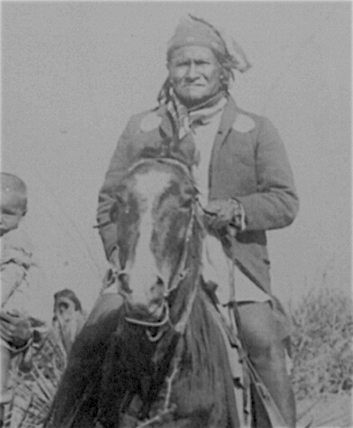
Source: Wikimedia
Geronimo - 1886
Part II
Cochise
When Mangas Coloradas was killed after surrendering in January of 1863, Cochise became the War Chief of the remaining bands of Apache. While Geronimo had an added hatred for the Mexicans, Cochise felt that way about the Americans. During this time period each warrior would continue to raid and attack their more hated enemy while also banding together when necessary to defeat any encroachment of their lands by outsiders.
Geronimo would continue attacking Mexicans by using guerilla tactics. They would sneak across the border through the mountains and valleys, and then pounce on settlements. From 1865 to 1867, Geronimo would make many successful incursions in to Mexico. Many of his tribe, including himself, believed him to be specially gifted with the ability to foretell future events as well as the ability to cloud his enemies sight in order to avoid being killed. He was also versed in using certain plants and herbs in treating and healing. Geronimo was believed to be a curandero by many of his tribe, and it was believed that this trait continued to keep him alive during his many battles.
Cochise and Geronimo would continue to fiercely resist the American Westward expansion, and thwart Mexican retaliation. The U.S. Government would try to coax peace into the Southwest region with the "blankets for peace" policy which helped by providing supplies to the Apache's such as food and blankets but was also an abused program. Then events like the Camp Grant Massacre of defenseless Apaches in 1871 would start a whole new cycle of hostilities in the region.
Unsettled Peace
Warfare against most Native Americans began to subside and peace was being brokered with the many tribes throughout the United States. The Apache nation would be one of the last tribes to negotiate peace. In 1872 Chief Cochise accepted a peace treaty, and the Chiricahua Apache Indian Reservation was established. Geronimo reluctantly accepted the peace treaty negotiated by his Chief. Geronimo's nomadic spirit, however, was not to be quelled and he would continue migratory treks between the new reservation and Mexico, his ancestral homelands. In 1873, the Mexican Government would make a peace accord with the Apaches. In celebration of the agreement, Mexicans gave the natives Mezcal, and when they were all asleep in a drunken stupor, the Mexican Troops attacked the Apaches, killing many of Geronimo's warriors.
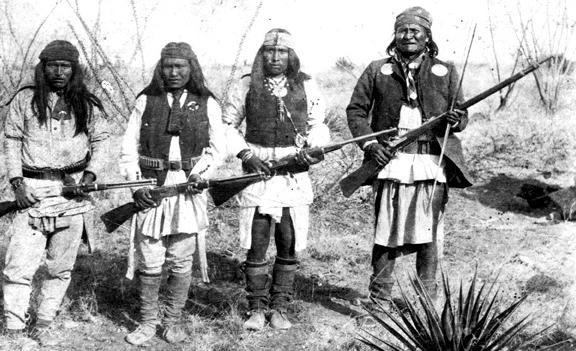
Source: Wikimedia
Geronimo, far right
1886
In 1874 Cochise died, and by 1876, the Government had closed down the Chiricahua Reservation. The Government then corralled the Apache into the San Carlos Apache Indian Reservation in 1877. Geronimo and his band would not stay here long in this desert environment. He preferred the Mountain Ranges of the Sierra Madre and would "break out" of the reservation many times. This would lead to both the American and the Mexican military to come chasing him and his band. During these times, his fame and legend would grow. He would elude both militaries with his intimate knowledge of the mountains and valleys. Apache warfare and raiding would continue for a few years more.
"Almost every year we would live a part of the time in Old Mexico. "
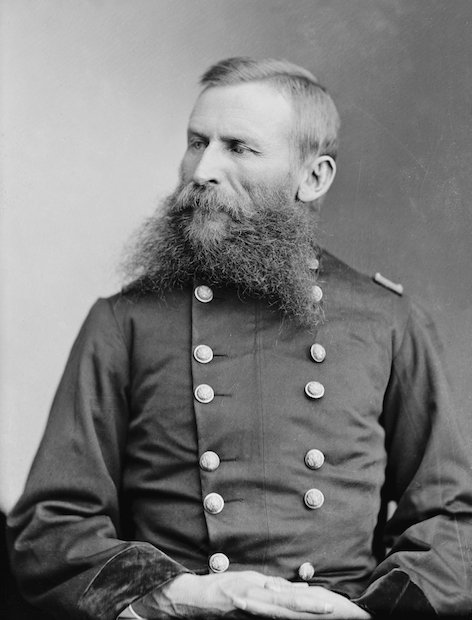
Source: Wikimedia
Gen. Crook - "Grey Wolf"
Final Surrender
In 1884, after many years of traveling between the San Carlos Reservation and his ancestral homelands in Mexico, Geronimo finally surrendered to General Crook. Crook was well respected by the Apache as a "man of his word." They nick named him Nantan Lupan, which means "Grey Wolf." Then in 1886, Geronimo's spirit yearned for freedom, and he left the reservation and headed back into Mexico. Gen. Crook was relentless in his pursuit of Geronimo, and his scouts tracked and found his camp in Mexico. On January 9, 1886, the Apache agreed to return to the reservation peacefully, but Geronimo remembering past betrayals, fled the next morning, much to the consternation of the Government in Washington. The Apaches were the only tribe not to settle permanently in a reservation, and Geronimo's feats were filling newspaper stories to the embarrassment of the government.
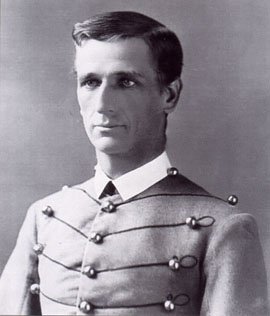
Source: Wikimedia
Lt. Charles B. Gatewood
General Crook was relieved, and replaced by General Nelson A. Miles. Miles assigned Lt. Charles B. Gatewood to pursue Geronimo into Mexico. Gatewood spoke Apache, and was well known and respected by the Apaches and Geronimo. Gatewood would pursue Geronimo deep into the mountains about 160 - 200 miles south of Douglas, Arizona between the Mexican states of Sonora and Chihuahua.
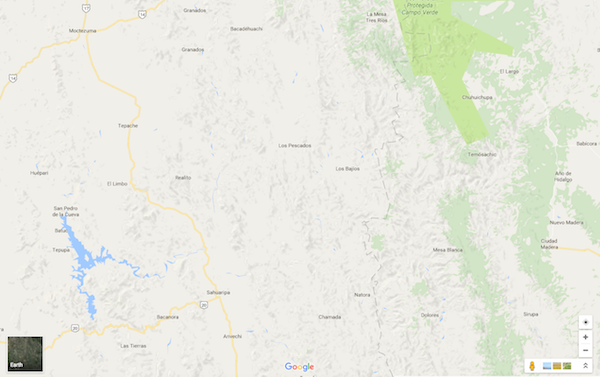
Source: Google Maps
Geronimo's Last Camp in the Sierra Madre Mountains of Mexico
Gatewood met with Geronimo in his camp and was able to convince him to peacefully surrender. Geronimo reluctantly agreed, but he was tired and running out of room to run. He agreed to surrender to General Miles on condition he keep his weapons until they were on American soil, Gatewood agreed. In fact, Lt. Gatewood would defend Geronimo with his own life, ensuring that on September 4, 1886, Geronimo surrendered to General Miles for the fourth and final time.
Prisoner of War
Within a few days of his surrender, Geronimo and all the Apaches, including the ones that aided in capture, were sent to Fort Pickens in Pensacola, Florida. Then they were transferred to Mobile, Alabama for seven more years before being permanently relocated to Fort Sill, Oklahoma in 1893. There Geronimo was given a plot of land, he built his home and lived with his family. His life exploits had made him a star attraction in his time, and he made many paid appearances at Fairs and Expos for the rest of his life. Then in February of 1909 he fell from a horse and was seriously injured. He died on February 17, 1909, at Fort Sill, a Prisoner of War.
"I should have never surrendered. I should have fought until I was the last man alive."
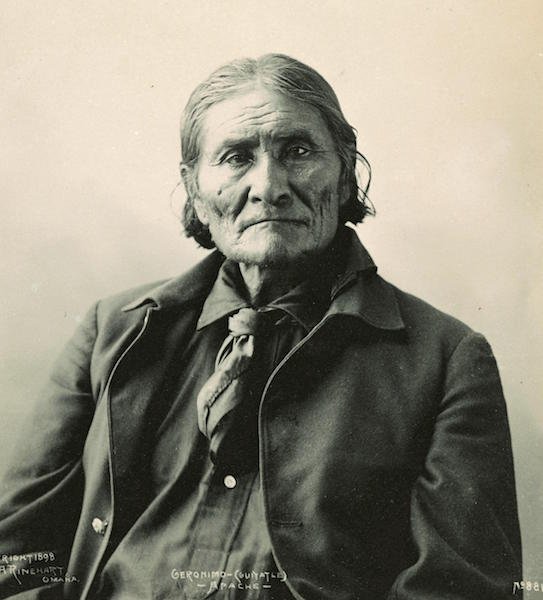
Source: Wikimedia
Geronimo - 1898
Full $teem Ahead!
@streetstyle
My Top Blogs
- Billy the Kid
- $1,500 into $15,000
Sources:
wikipedia.org
indigenouspeople.net
https://www.preceden.com/timelines/49338-geronimo
pinterest.com
http://jodybresch.com/geronimofamily.htm
http://www.let.rug.nl/usa/biographies/geronimo/
http://www.indians.org/welker/geronimo.htm
maps.google.com
http://wildsonora.com/image-content/rio-aros-morita-rapid-panorama
http://cochisestrongholdranch.net/id78.html
http://ndepth.newsok.com/geronimo
https://www.warpaths2peacepipes.com/famous-native-americans/geronimo.htm
Well written and informative. Up-Voted and followed BUT.....
Steem On!!
Thanks @majes
full $teem ahead!
Keep it up. Thanks.
We're just on the other side of Mount Graham from what later became Fort Grant. You can visit, though I haven't yet. The San Carlos reservation is just west of us, and the Chiricahua Mountains are to the south. It's pretty cool to read this and think about the areas around us.
To this day when driving through that whole area my mind wanders with with all the history that took place there @anotherjoe Thanks for the interest and support.
full $teem ahead!
I respect the American Indians and too bad they lost their lands.
Upvoted n following. Look at my content. Thanks.
Thanks for your support @hanamana And of course I will. Thank again.
full $teem ahead!
nice
supported
Thanks @bullionstackers Nice to know
full $teem ahead!